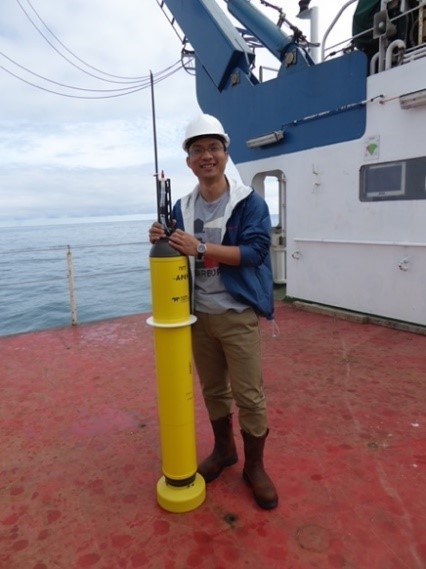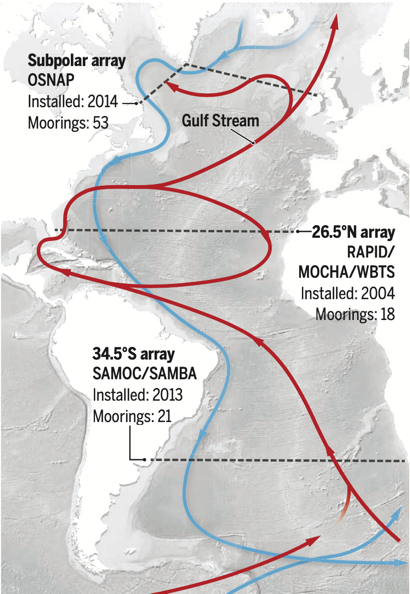李非栗于2014年获得美国特拉华大学的物理海洋学博士学位,随后在美国乔治梅森大学、杜克大学从事博士后研究,回国前为佐治亚理工学院高级研究员。2021年2月加盟91看自拍海洋与地球学院物理海洋学系,并成为91看自拍的固定科研人员。
李非栗博士致力于大洋环流及其气候变化领域的研究,尤其关注海洋经向翻转环流及其对大尺度海洋热、盐输送与淡水交换的影响。其课题组的近期研究兴趣主要包括:(1)海洋经向翻转环流变化规律与机制;(2)跨洋盆热量及淡水交换特征与驱动过程;(3)海洋现场观测和海洋遥感。

【图1:李非栗博士2016年在RRS Discovery北大西洋航次上进行ARGO浮标投放作业】
现代海洋翻转环流以大西洋经向翻转环流(AMOC)为主导,其变异直接影响大洋热量、淡水分布,及全球碳循环等生物地球化学过程,是全球气候变化的关键性影响因素。因此AMOC研究对于增进人们理解海洋在地球系统中的作用和机制,提高气候模拟精度和对未来气候变化预测至关重要。

【图2:大西洋经向翻转环流(AMOC)主要包含由南向北流动的高温高盐表层水(红色)和由南向北流动的低温低盐深层水(蓝色)。图中虚线代表的是AMOC潜标观测系统的位置。图片来源:https://www.science.org/doi/10.1126/science.352.6287.751】
李非栗博士近年来对AMOC的结构特征及变化机制开展了较为系统的研究。例如,基于北大西洋副极地OSNAP阵列(见上图)的现场观测数据,揭示了副极地AMOC的时空结构特性,阐明了影响AMOC变异的深层密度异常的具体位置和传播路径,特别指出了拉布拉多海深对流过程对AMOC变异的有限影响及可能的原因。利用历史水文断面观测数据,对AMOC的年际和年代际变率进行重建与分析,指出上世纪九十年代以来AMOC强度相对稳定,而并非如模式结果所展示的已经开始减缓。进一步与海洋模式专家合作,分析了海洋模式中对AMOC变异机制模拟偏差的可能原因,为衡量气候模式对关键性大尺度海洋物理过程模拟的可信度提供评价指标。此外,李非栗博士同合作者们通过收集整合历史水文观测数据,分析大西洋中高纬度热、盐输送的基本特征,其与海洋热量、淡水含量变化之间的关系,对大洋环流在海洋热量及海平面变化中的作用、相应的时间尺度及机制进行了系统的分析。
近期研究成果速递:
观测研究揭示亚极地海域热量和淡水交换与海洋翻转环流耦合关系的差异性
最新观测揭示大西洋副极地深海西边界流和经向翻转环流变化特征
如有兴趣了解李非栗博士的更多情况,欢迎访问其个人主页http://mel2.xmu.edu.cn/faculty/FeiliLi/,或联系feili.li@xmu.edu.cn.
Dr Feili Li——A Physical Oceanographer Studying Large-Scale Ocean Circulation and its Role in the Climate System
Dr. Feili Li received his PhD in Physical Oceanography in 2014 from the University of Delaware. Shortly after he graduated, Li worked at George Mason University and then Duke University as a postdoctoral researcher. He was a Senior Research Scientist at the Georgia Institute of Technology before joining MEL. Li joined the Department of Physical Oceanography at Xiamen University (XMU) and became a faculty member of the State Key Laboratory of Marine Environmental Science (MEL) in February 2021.
Li's research is focused on large-scale ocean circulation and its role in the climate system, especially those related to the global ocean's Meridional Overturning Circulation (MOC). His research group's interests include: (1) overturning characteristics and dynamics; (2) the underlying mechanism of the inter-basin heat and freshwater exchanges; (3) the integration of ocean observations and ocean remote sensing data etc.
The modern ocean's MOC is manifested in the Atlantic Ocean and is known as the AMOC. The AMOC is a key component in the Earth's climate system. Its variability is believed to affect the distribution of large amount of oceanic heat and freshwater andthe global carbon cycle as well as other biogeochemical processes. As part of an internationally collaborative project, Li has been carrying out research projects on understanding the characteristics and mechanisms of the AMOC. For example, a recent work based on moored records revealing the spatio-temporal structures of the subpolar AMOC, elucidated the formation sites and propagation pathways of deep density anomaly that is associated with the overturning variability, and demonstrates the weak influence of deep convective processes in the Labrador Sea on the observed variability. Another work revealed the stability of the AMOC since the 1990s based on a reconstruction of the longer term AMOC variability from historical hydrographic data. By examining multiple ocean-sea ice models, a follow-up study shows possible reasons for model biases in the AMOC simulations. These studies have brought new insights into our understandings of the AMOC variability, calling for a comprehensive reevaluation of the efficacy and robustness of climate model simulations of key large-scale ocean physical processes.
Li and his collaborators collected available historical hydrographic data at various trans-Atlantic sections to provide observation-based estimates of the basin-wide heat and salinity transports through the mid- to high-latitudes of the North Atlantic Ocean and delineated the relationships with the variability in the ocean heat and freshwater contents. Those studies have brought new insights into the role of ocean circulation in ocean heat and sea level changes.
For more information, please visit Dr. Feili Li's website http://mel2.xmu.edu.cn/faculty/FeiliLi/, or contact him at feili.li@xmu.edu.cn.